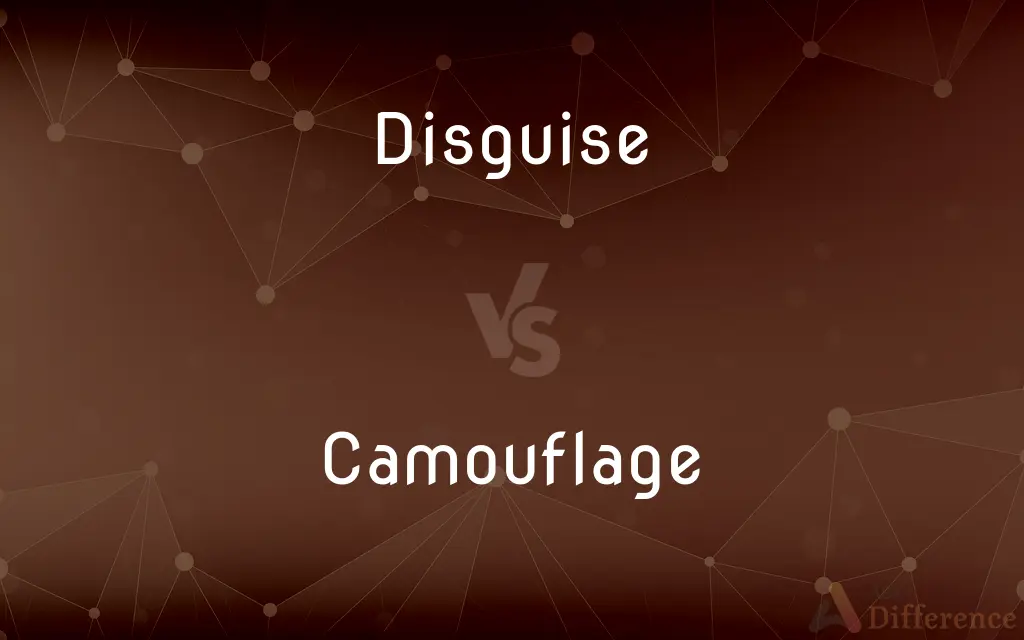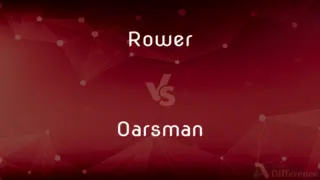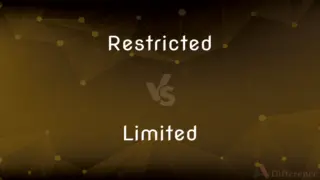Disguise vs. Camouflage — What's the Difference?
Edited by Tayyaba Rehman — By Urooj Arif — Updated on April 15, 2024
Disguise involves altering appearance to hide identity, primarily used by people; camouflage, however, pertains to blending with the environment, often seen in military or animal contexts.

Difference Between Disguise and Camouflage
Table of Contents
ADVERTISEMENT
Key Differences
Disguise is typically used by individuals to conceal their identity or to appear as someone else, whereas camouflage is used primarily to blend into surrounding environments to avoid detection.
In the context of human use, disguises might involve masks, costumes, or makeup to alter one's appearance, whereas camouflage in a military setting often involves using colors and patterns that mimic the surroundings.
Disguise can also include changes in behavior or mannerisms to support the new identity, on the other hand, camouflage may involve remaining motionless or silent to improve its effectiveness.
While disguises are often employed in entertainment, espionage, or criminal activity to fool others, camouflage is crucial in nature for survival, used by animals to evade predators or by predators to ambush prey.
Disguises are temporary and are actively put on or taken off, whereas camouflage can be a permanent part of an organism’s physical traits or a specific gear like a ghillie suit in military applications.
ADVERTISEMENT
Comparison Chart
Primary Use
Conceal identity or role
Blend with the environment
Common Contexts
Entertainment, espionage, personal
Military, wildlife
Methods
Costumes, makeup, prosthetics
Patterns, colors, mimicry
Duration
Temporary, changeable
Can be permanent or temporary
Behavioral Element
May involve acting or mimicry
Often involves stillness or strategic movement
Compare with Definitions
Disguise
Transformation for covert purposes.
The spy used a clever disguise to access the restricted building.
Camouflage
Fabric or material with natural color patterns.
His jacket was made of camouflage material for hunting.
Disguise
Implementation of digital or physical alterations to conceal.
The artist disguised his voice with a modulator during the performance.
Camouflage
Use of natural or artificial means to blend into an environment.
The soldiers wore camouflage to blend into the forest.
Disguise
Use of props to change one's look.
Her disguise included a false beard and a wig.
Camouflage
Adaptive coloration in animals.
The chameleon’s camouflage changes colors based on its surroundings.
Disguise
Masking of intentions or feelings.
She used laughter as a disguise for her disappointment.
Camouflage
Application in military tactics.
Camouflage tactics were crucial in their strategy to remain undetected.
Disguise
Alteration of appearance to hide identity.
He wore a disguise of glasses and a hat to avoid recognition.
Camouflage
Techniques to evade detection.
The sniper used camouflage netting to conceal his position.
Disguise
A disguise can be anything which conceals or changes a person's physical appearance, including a wig, glasses, makeup, fake moustache, costume or other items. Camouflage is a type of disguise for people, animals and objects.
Camouflage
Camouflage is the use of any combination of materials, coloration, or illumination for concealment, either by making animals or objects hard to see, or by disguising them as something else. Examples include the leopard's spotted coat, the battledress of a modern soldier, and the leaf-mimic katydid's wings.
Disguise
To modify the manner or appearance of (a person, for example) in order to prevent recognition
Disguised himself as a guard and escaped.
Camouflage
The concealing of personnel or equipment from an enemy by making them appear to be part of the natural surroundings.
Disguise
To make indistinct or difficult to perceive
Disguised the bad taste of the medicine with lemon syrup.
Camouflage
Protective coloring or other appearance that conceals an animal and enables it to blend into its surroundings
The leopard's camouflage makes it blend in with the forest shadows.
Disguise
To conceal or obscure by dissemblance or false show; misrepresent
Disguise one's true intentions.
Camouflage
Cloth, netting, or other material used for camouflage
Spread the camouflage over the tank.
Disguise
Clothes or accessories worn to conceal one's true identity.
Camouflage
Fabric or a garment dyed in splotches of green, brown, and tan, used for camouflage in certain environments.
Disguise
Appearance that misrepresents the true character of something
A blessing in disguise.
Camouflage
To conceal by the use of camouflage.
Disguise
A pretense or misrepresentation
His repeated references to his dangerous hobbies were only a disguise to cover up his insecurity.
Camouflage
To conceal, usually through misrepresentation or other artifice
Camouflaged their hatred with professions of friendship.
Disguise
Material (such as clothing, makeup, a wig) used to alter one’s visual appearance in order to hide one's identity or assume another.
A cape and moustache completed his disguise.
Camouflage
To use camouflage for concealment.
Disguise
(figuratively) The appearance of something on the outside which masks what’s beneath.
Camouflage
A disguise or covering up.
Disguise
The act or state of disguising, notably as a ploy.
Any disguise may expose soldiers to be deemed enemy spies.
Camouflage
The act of disguising.
Disguise
(archaic) A change of behaviour resulting from intoxication, drunkenness.
Camouflage
(military) The use of natural or artificial material on personnel, objects, or tactical positions with the aim of confusing, misleading, or evading the enemy.
Disguise
(transitive) To change the appearance of (a person or thing) so as to hide, or to assume an identity.
Spies often disguise themselves.
Camouflage
(textiles) A pattern on clothing consisting of irregularly shaped patches that are either greenish/brownish, brownish/whitish, or bluish/whitish, as used by ground combat forces.
Disguise
To transform or disfigure, to change the appearance of in general.
Camouflage
(biology) Resemblance of an organism to its surroundings for avoiding detection.
Disguise
(transitive) To avoid giving away or revealing (something secret); to hide by a false appearance.
He disguised his true intentions.
Camouflage
Clothes made from camouflage fabric, for concealment in combat or hunting.
Disguise
To dress in newfangled or showy clothing, to deck out in new fashions.
Camouflage
To hide or disguise something by covering it up or changing the way it looks.
Disguise
To dissemble, to talk or act falsely while concealing one’s thoughts.
Camouflage
An outward semblance that misrepresents the true nature of something;
The theatrical notion of disguise is always associated with catastrophe in his stories
Disguise
To affect or change by liquor; to intoxicate.
Camouflage
Fabric dyed with splotches of green and brown and black and tan; intended to make the wearer of a garment made of this fabric hard to distinguish from the background
Disguise
To change the guise or appearance of; especially, to conceal by an unusual dress, or one intended to mislead or deceive.
Bunyan was forced to disguise himself as a wagoner.
Camouflage
Device or stratagem for concealment or deceit
Disguise
To hide by a counterfeit appearance; to cloak by a false show; to mask; as, to disguise anger; to disguise one's sentiments, character, or intentions.
All God's angels come to us disguised.
Camouflage
The act of concealing the identity of something by modifying its appearance;
He is a master of disguise
Disguise
To affect or change by liquor; to intoxicate.
I have just left the right worshipful, and his myrmidons, about a sneaker of five gallons; the whole magistracy was pretty well disguised before I gave them the ship.
Camouflage
Disguise by camouflaging; exploit the natural surroundings to disguise something;
The troops camoflaged themselves before they went into enemy territory
Disguise
A dress or exterior put on for purposes of concealment or of deception; as, persons doing unlawful acts in disguise are subject to heavy penalties.
There is no passion which steals into the heart more imperceptibly and covers itself under more disguises, than pride.
Disguise
Artificial language or manner assumed for deception; false appearance; counterfeit semblance or show.
That eye which glances through all disguises.
Disguise
Change of manner by drink; intoxication.
Disguise
A masque or masquerade.
Disguise was the old English word for a masque.
Disguise
An outward semblance that misrepresents the true nature of something;
The theatrical notion of disguise is always associated with catastrophe in his stories
Disguise
Any attire that modifies the appearance in order to conceal the wearer's identity
Disguise
The act of concealing the identity of something by modifying its appearance;
He is a master of disguise
Disguise
Make unrecognizable;
The herb disguises the garlic taste
We disguised our faces before robbing the bank
Common Curiosities
How does camouflage work in the animal kingdom?
Animals use colors, patterns, and behaviors to blend into their environments, reducing visibility.
Can disguises be used for purposes other than entertainment?
Yes, disguises are also used in espionage and personal security.
What materials are common for physical disguises?
Masks, makeup, and costumes are commonly used.
What is the purpose of a disguise?
To conceal someone's identity or transform their appearance.
Are there ethical concerns associated with using disguises?
Yes, particularly when used to deceive or harm others.
Can digital technology be considered a form of disguise?
Yes, digital alterations to modify appearance or voice are modern forms of disguises.
How do children use disguises in play?
Children often use costumes and role-playing as forms of disguise for entertainment.
What is mimicry in the context of camouflage?
Mimicry involves adopting the appearance of something else, often another organism, to deceive observers.
Can disguises affect one's behavior?
Yes, adopting a disguise can sometimes influence a person's behavior and mannerisms.
Is camouflage always visual?
No, it can also involve olfactory or auditory elements to deceive predators or prey.
What role does the environment play in camouflage?
The environment is crucial as it dictates what patterns and colors are effective.
How important is behavior in effective camouflage?
Very important; often, movement can give away a camouflaged position.
Share Your Discovery

Previous Comparison
Rower vs. Oarsman
Next Comparison
Restricted vs. LimitedAuthor Spotlight
Written by
Urooj ArifUrooj is a skilled content writer at Ask Difference, known for her exceptional ability to simplify complex topics into engaging and informative content. With a passion for research and a flair for clear, concise writing, she consistently delivers articles that resonate with our diverse audience.
Edited by
Tayyaba RehmanTayyaba Rehman is a distinguished writer, currently serving as a primary contributor to askdifference.com. As a researcher in semantics and etymology, Tayyaba's passion for the complexity of languages and their distinctions has found a perfect home on the platform. Tayyaba delves into the intricacies of language, distinguishing between commonly confused words and phrases, thereby providing clarity for readers worldwide.
















































